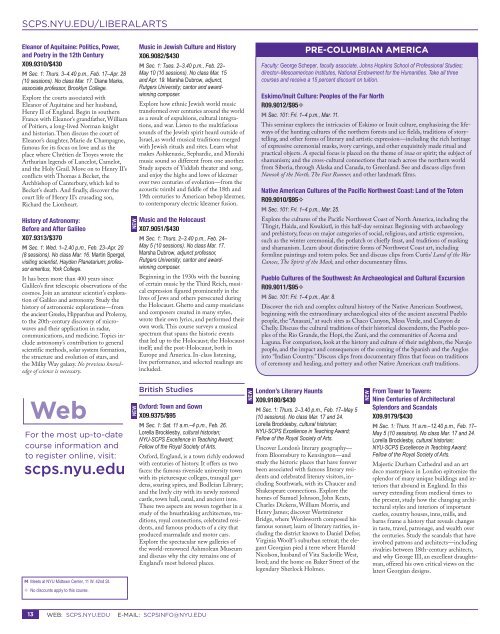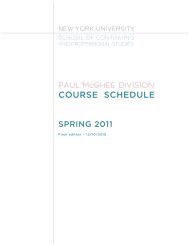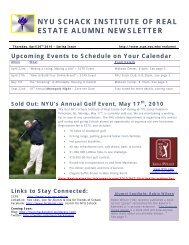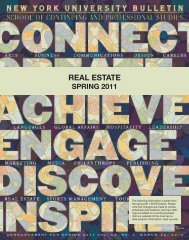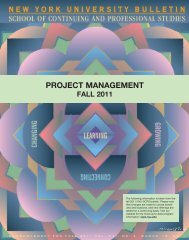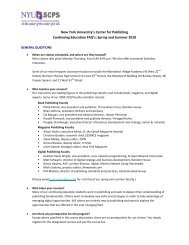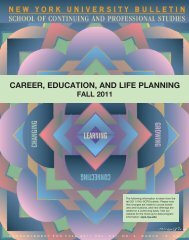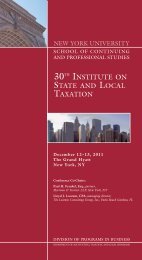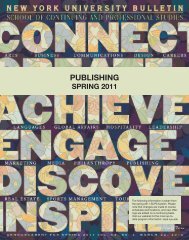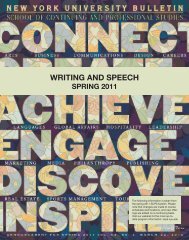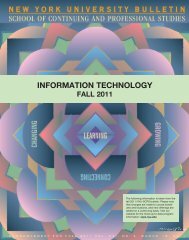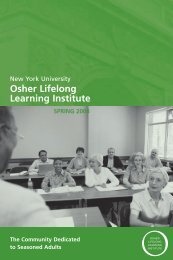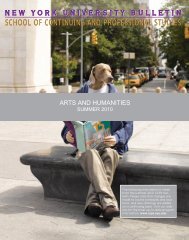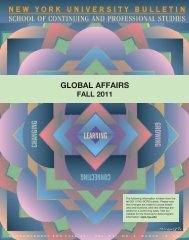LIBERAL STUDIES AND ALLIED ARTS - School of Continuing and ...
LIBERAL STUDIES AND ALLIED ARTS - School of Continuing and ...
LIBERAL STUDIES AND ALLIED ARTS - School of Continuing and ...
You also want an ePaper? Increase the reach of your titles
YUMPU automatically turns print PDFs into web optimized ePapers that Google loves.
SCPS.NYU.EDU/<strong>LIBERAL</strong><strong>ARTS</strong><br />
Eleanor <strong>of</strong> Aquitaine: Politics, Power,<br />
<strong>and</strong> Poetry in the 12th Century<br />
X09.9310/$430<br />
M Sec. 1: Thurs. 3–4.40 p.m., Feb. 17–Apr. 28<br />
(10 sessions). No class Mar. 17. Diane Marks,<br />
associate pr<strong>of</strong>essor, Brooklyn College.<br />
Explore the courts associated with<br />
Eleanor <strong>of</strong> Aquitaine <strong>and</strong> her husb<strong>and</strong>,<br />
Henry II <strong>of</strong> Engl<strong>and</strong>. Begin in southern<br />
France with Eleanor’s gr<strong>and</strong>father, William<br />
<strong>of</strong> Poitiers, a long-lived Norman knight<br />
<strong>and</strong> historian. Then discuss the court <strong>of</strong><br />
Eleanor’s daughter, Marie de Champagne,<br />
famous for its focus on love <strong>and</strong> as the<br />
place where Chrétien de Troyes wrote the<br />
Arthurian legends <strong>of</strong> Lancelot, Camelot,<br />
<strong>and</strong> the Holy Grail. Move on to Henry II’s<br />
conflicts with Thomas à Becket, the<br />
Archbishop <strong>of</strong> Canterbury, which led to<br />
Becket’s death. And finally, discover the<br />
court life <strong>of</strong> Henry II’s crusading son,<br />
Richard the Lionheart.<br />
History <strong>of</strong> Astronomy:<br />
Before <strong>and</strong> After Galileo<br />
X07.9313/$370<br />
M Sec. 1: Wed. 1–2.40 p.m., Feb. 23–Apr. 20<br />
(8 sessions). No class Mar. 16. Martin Spergel,<br />
visiting scientist, Hayden Planetarium; pr<strong>of</strong>essor<br />
emeritus, York College.<br />
It has been more than 400 years since<br />
Galileo’s first telescopic observations <strong>of</strong> the<br />
cosmos. Join an amateur scientist’s exploration<br />
<strong>of</strong> Galileo <strong>and</strong> astronomy. Study the<br />
history <strong>of</strong> astronomic explorations—from<br />
the ancient Greeks, Hipparchus <strong>and</strong> Ptolemy,<br />
to the 20th-century discovery <strong>of</strong> microwaves<br />
<strong>and</strong> their application in radar,<br />
communications, <strong>and</strong> medicine. Topics include<br />
astronomy’s contribution to general<br />
scientific methods, solar system formation,<br />
the structure <strong>and</strong> evolution <strong>of</strong> stars, <strong>and</strong><br />
the Milky Way galaxy. No previous knowledge<br />
<strong>of</strong> science is necessary.<br />
NEW<br />
Music in Jewish Culture <strong>and</strong> History<br />
X06.9082/$430<br />
M Sec. 1: Tues. 2–3.40 p.m., Feb. 22–<br />
May 10 (10 sessions). No class Mar. 15<br />
<strong>and</strong> Apr. 19. Marsha Dubrow, adjunct,<br />
Rutgers University; cantor <strong>and</strong> awardwinning<br />
composer.<br />
Explore how ethnic Jewish world music<br />
transformed over centuries around the world<br />
as a result <strong>of</strong> expulsions, cultural integrations,<br />
<strong>and</strong> war. Listen to the multifarious<br />
sounds <strong>of</strong> the Jewish spirit heard outside <strong>of</strong><br />
Israel, as world musical traditions merged<br />
with Jewish rituals <strong>and</strong> rites. Learn what<br />
makes Ashkenazic, Sephardic, <strong>and</strong> Mizrahi<br />
music sound so different from one another.<br />
Study aspects <strong>of</strong> Yiddish theater <strong>and</strong> song,<br />
<strong>and</strong> enjoy the highs <strong>and</strong> lows <strong>of</strong> klezmer<br />
over two centuries <strong>of</strong> evolution—from the<br />
acoustic tsimbl <strong>and</strong> fiddle <strong>of</strong> the 18th <strong>and</strong><br />
19th centuries to American bebop klezmer,<br />
to contemporary electric klezmer fusion.<br />
Music <strong>and</strong> the Holocaust<br />
X07.9051/$430<br />
M Sec. 1: Thurs. 2–3.40 p.m., Feb. 24–<br />
May 5 (10 sessions). No class Mar. 17.<br />
Marsha Dubrow, adjunct pr<strong>of</strong>essor,<br />
Rutgers University; cantor <strong>and</strong> awardwinning<br />
composer.<br />
Beginning in the 1930s with the banning<br />
<strong>of</strong> certain music by the Third Reich, musical<br />
expression figured prominently in the<br />
lives <strong>of</strong> Jews <strong>and</strong> others persecuted during<br />
the Holocaust. Ghetto <strong>and</strong> camp musicians<br />
<strong>and</strong> composers created in many styles,<br />
wrote their own lyrics, <strong>and</strong> performed their<br />
own work. This course surveys a musical<br />
spectrum that spans the historic events<br />
that led up to the Holocaust; the Holocaust<br />
itself; <strong>and</strong> the post-Holocaust, both in<br />
Europe <strong>and</strong> America. In-class listening,<br />
live performance, <strong>and</strong> selected readings are<br />
included.<br />
PRE-COLUMBIAN AMERICA<br />
Faculty: George Scheper, faculty associate, Johns Hopkins <strong>School</strong> <strong>of</strong> Pr<strong>of</strong>essional Studies;<br />
director–Mesoamerican Institutes, National Endowment for the Humanities. Take all three<br />
courses <strong>and</strong> receive a 15 percent discount on tuition.<br />
Eskimo/Inuit Culture: Peoples <strong>of</strong> the Far North<br />
R09.9012/$95G<br />
M Sec. 101: Fri. 1–4 p.m., Mar. 11.<br />
This seminar explores the intricacies <strong>of</strong> Eskimo or Inuit culture, emphasizing the lifeways<br />
<strong>of</strong> the hunting cultures <strong>of</strong> the northern forests <strong>and</strong> ice fields, traditions <strong>of</strong> storytelling,<br />
<strong>and</strong> other forms <strong>of</strong> literary <strong>and</strong> artistic expression—including the rich heritage<br />
<strong>of</strong> expressive ceremonial masks, ivory carvings, <strong>and</strong> other exquisitely made ritual <strong>and</strong><br />
practical objects. A special focus is placed on the theme <strong>of</strong> inua or spirit; the subject <strong>of</strong><br />
shamanism; <strong>and</strong> the cross-cultural connections that reach across the northern world<br />
from Siberia, through Alaska <strong>and</strong> Canada, to Greenl<strong>and</strong>. See <strong>and</strong> discuss clips from<br />
Nanook <strong>of</strong> the North, The Fast Runner, <strong>and</strong> other l<strong>and</strong>mark films.<br />
Native American Cultures <strong>of</strong> the Pacific Northwest Coast: L<strong>and</strong> <strong>of</strong> the Totem<br />
R09.9010/$95G<br />
M Sec. 101: Fri. 1–4 p.m., Mar. 25.<br />
Explore the cultures <strong>of</strong> the Pacific Northwest Coast <strong>of</strong> North America, including the<br />
Tlingit, Haida, <strong>and</strong> Kwakiutl, in this half-day seminar. Beginning with archaeology<br />
<strong>and</strong> prehistory, focus on major categories <strong>of</strong> social, religious, <strong>and</strong> artistic expression,<br />
such as the winter ceremonial, the potlatch or chiefly feast, <strong>and</strong> traditions <strong>of</strong> masking<br />
<strong>and</strong> shamanism. Learn about distinctive forms <strong>of</strong> Northwest Coast art, including<br />
formline paintings <strong>and</strong> totem poles. See <strong>and</strong> discuss clips from Curtis’ L<strong>and</strong> <strong>of</strong> the War<br />
Canoes, The Spirit <strong>of</strong> the Mask, <strong>and</strong> other documentary films.<br />
Pueblo Cultures <strong>of</strong> the Southwest: An Archaeological <strong>and</strong> Cultural Excursion<br />
R09.9011/$95G<br />
M Sec. 101: Fri. 1–4 p.m., Apr. 8.<br />
Discover the rich <strong>and</strong> complex cultural history <strong>of</strong> the Native American Southwest,<br />
beginning with the extraordinary archaeological sites <strong>of</strong> the ancient ancestral Pueblo<br />
people, the “Anasazi,” at such sites as Chaco Canyon, Mesa Verde, <strong>and</strong> Canyon de<br />
Chelly. Discuss the cultural traditions <strong>of</strong> their historical descendents, the Pueblo peoples<br />
<strong>of</strong> the Rio Gr<strong>and</strong>e, the Hopi, the Zuni, <strong>and</strong> the communities <strong>of</strong> Acoma <strong>and</strong><br />
Laguna. For comparison, look at the history <strong>and</strong> culture <strong>of</strong> their neighbors, the Navajo<br />
people, <strong>and</strong> the impact <strong>and</strong> consequences <strong>of</strong> the coming <strong>of</strong> the Spanish <strong>and</strong> the Anglos<br />
into “Indian Country.” Discuss clips from documentary films that focus on traditions<br />
<strong>of</strong> ceremony <strong>and</strong> healing, <strong>and</strong> pottery <strong>and</strong> other Native American craft traditions.<br />
Web<br />
For the most up-to-date<br />
course information <strong>and</strong><br />
to register online, visit:<br />
scps.nyu.edu<br />
M Meets at NYU Midtown Center, 11 W. 42nd St.<br />
G No discounts apply to this course.<br />
NEW<br />
British Studies<br />
Oxford: Town <strong>and</strong> Gown<br />
X09.9375/$95<br />
M Sec. 1: Sat. 11 a.m.–4 p.m., Feb. 26.<br />
Lorella Brocklesby, cultural historian;<br />
NYU-SCPS Excellence in Teaching Award;<br />
Fellow <strong>of</strong> the Royal Society <strong>of</strong> Arts.<br />
Oxford, Engl<strong>and</strong>, is a town richly endowed<br />
with centuries <strong>of</strong> history. It <strong>of</strong>fers us two<br />
faces: the famous riverside university town<br />
with its picturesque colleges, tranquil gardens,<br />
soaring spires, <strong>and</strong> Bodleian Library;<br />
<strong>and</strong> the lively city with its newly restored<br />
castle, town hall, canal, <strong>and</strong> ancient inns.<br />
These two aspects are woven together in a<br />
study <strong>of</strong> the breathtaking architecture, traditions,<br />
royal connections, celebrated residents,<br />
<strong>and</strong> famous products <strong>of</strong> a city that<br />
produced marmalade <strong>and</strong> motor cars.<br />
Explore the spectacular new galleries <strong>of</strong><br />
the world-renowned Ashmolean Museum<br />
<strong>and</strong> discuss why the city remains one <strong>of</strong><br />
Engl<strong>and</strong>’s most beloved places.<br />
NEW<br />
London’s Literary Haunts<br />
X09.9180/$430<br />
M Sec. 1: Thurs. 2–3.40 p.m., Feb. 17–May 5<br />
(10 sessions). No class Mar. 17 <strong>and</strong> 24.<br />
Lorella Brocklesby, cultural historian;<br />
NYU-SCPS Excellence in Teaching Award;<br />
Fellow <strong>of</strong> the Royal Society <strong>of</strong> Arts.<br />
Uncover London’s literary geography—<br />
from Bloomsbury to Kensington—<strong>and</strong><br />
study the historic places that have forever<br />
been associated with famous literary residents<br />
<strong>and</strong> celebrated literary visitors, including<br />
Southwark, with its Chaucer <strong>and</strong><br />
Shakespeare connections. Explore the<br />
homes <strong>of</strong> Samuel Johnson, John Keats,<br />
Charles Dickens, William Morris, <strong>and</strong><br />
Henry James; discover Westminster<br />
Bridge, where Wordsworth composed his<br />
famous sonnet; learn <strong>of</strong> literary rarities, including<br />
the district known to Daniel Defoe;<br />
Virginia Woolf ’s suburban retreat; the elegant<br />
Georgian pied á terre where Harold<br />
Nicolson, husb<strong>and</strong> <strong>of</strong> Vita Sackville West,<br />
lived; <strong>and</strong> the home on Baker Street <strong>of</strong> the<br />
legendary Sherlock Holmes.<br />
NEW<br />
From Tower to Tavern:<br />
Nine Centuries <strong>of</strong> Architectural<br />
Splendors <strong>and</strong> Sc<strong>and</strong>als<br />
X09.9179/$430<br />
M Sec. 1: Thurs. 11 a.m.–12.40 p.m., Feb. 17–<br />
May 5 (10 sessions). No class Mar. 17 <strong>and</strong> 24.<br />
Lorella Brocklesby, cultural historian;<br />
NYU-SCPS Excellence in Teaching Award;<br />
Fellow <strong>of</strong> the Royal Society <strong>of</strong> Arts.<br />
Majestic Durham Cathedral <strong>and</strong> an art<br />
deco masterpiece in London epitomize the<br />
splendor <strong>of</strong> many unique buildings <strong>and</strong> interiors<br />
that abound in Engl<strong>and</strong>. In this<br />
survey extending from medieval times to<br />
the present, study how the changing architectural<br />
styles <strong>and</strong> interiors <strong>of</strong> important<br />
castles, country houses, inns, mills, <strong>and</strong><br />
barns frame a history that reveals changes<br />
in taste, travel, patronage, <strong>and</strong> wealth over<br />
the centuries. Study the sc<strong>and</strong>als that have<br />
involved patrons <strong>and</strong> architects—including<br />
rivalries between 18th-century architects,<br />
<strong>and</strong> why George III, an excellent draughtsman,<br />
<strong>of</strong>fered his own critical views on the<br />
latest Georgian designs.<br />
13<br />
WEB: SCPS.NYU.EDU<br />
E-MAIL: SCPSINFO@NYU.EDU


